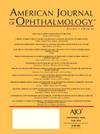配戴不同后视区直径角膜塑形镜儿童角膜的轴向生长和经络调节。
IF 4.1
1区 医学
Q1 OPHTHALMOLOGY
引用次数: 0
摘要
目的评价不同后光学带直径(BOZD)角膜塑形镜对角膜相对屈光度偏移(RCRPS)的影响,并探讨其与角膜轴长生长(ALG)的关系。DESIGNA随机、双盲、对照临床试验。方法受试者年龄在8 ~ 15岁之间,屈光度为-1.0 ~ -4.00 d,随机分为两组,佩戴BOZD_5.0mm和BOZD_6.2mm镜片。在晶状体磨损后基线和12个月测量眼轴长(AL),计算眼轴长(ALG)和年龄调整眼轴长(aALG)。比较12个月和基线角膜地形图的差异图用于分析RCRPS,在中心直径4mm范围内汇总。RCRPS子集以45度的间隔分为8条经脉。采用线性和逐步多元线性回归来评估ALG与RCRPS之间的关系。结果两组患者年龄、球当量、AL等基线参数差异无统计学意义(P < 0.05)。12个月后,佩戴BOZD_5.0mm镜片的儿童ALG(0.15±0.13 mm)明显低于佩戴BOZD_6.2mm镜片的儿童ALG(0.24±0.17 mm, P = 0.04)。BOZD_5.0mm组aALG也显著减慢(-0.10±0.12 mm vs -0.001±0.16 mm, P = 0.01)。配戴BOZD_5.0mm镜片的儿童中央4mm区域的总RCRPS(92.31±43.21 D)显著高于配戴BOZD_6.2mm镜片的儿童(70.04±41.64 D, P = 0.04)。总RCRPS仅在0度、45度和90度经络组间有显著差异(均P < 0.01)。在8个不同经络上分析aALG与RCRPS的相关性。只有0度、45度和90度经络表现出显著的相关性。结论佩戴BOZD较小的角膜塑形镜的儿童ALG较慢。ALG的差异与角膜鼻上象限的RCRPS升高有关。本文章由计算机程序翻译,如有差异,请以英文原文为准。
Axial growth and meridian modulation of cornea power in children wearing orthokeratology lenses of different back optic zone diameters.
PURPOSE
To evaluate the effect of orthokeratology lenses with different back optical zone diameters (BOZD) on relative corneal refraction power shift (RCRPS) and explore its association with axial length growth (ALG).
DESIGN
A randomized, double-blinded, controlled clinical trial.
METHODS
Subjects aged between 8 and 15 years, with the refraction of -1.0 to -4.00 D. Participants were randomly assigned to two groups, wearing a BOZD_5.0mm or a BOZD_6.2mm lenses. Axial length (AL) was measured at baseline and 12 months after lens wear, and ALG and age-adjusted ALG (aALG) were calculated. A differential map comparing the 12-month and baseline corneal topography was used to analyze the RCRPS, summed within the central 4 mm diameter. The RCRPS subset was divided into eight meridians at 45-degree intervals. Linear and stepwise multiple linear regression were performed to assess the associations between ALG and RCRPS.
RESULTS
There was no significant difference in baseline parameters, including age, spherical equivalent, and AL (all P > 0.05). Over 12 months, children wearing BOZD_5.0mm lens demonstrated significantly slower ALG (0.15 ± 0.13 mm) than those wearing BOZD_6.2mm lenses (0.24 ± 0.17 mm, P = 0.04). aALG was also significantly slower in BOZD_5.0mm group (-0.10 ± 0.12 mm vs. -0.001 ± 0.16 mm, P = 0.01). The summed RCRPS within the central 4mm area was significantly greater in children wearing BOZD_5.0mm lenses (92.31 ± 43.21 D) when compared to children wearing BOZD_6.2mm lenses (70.04 ± 41.64 D, P = 0.04). The summed RCRPS only demonstrated significant differences between the groups on 0-, 45-, and 90-degree meridians (all P < 0.01). The association between aALG and summed RCRPS was analyzed on eight different meridians. Only the 0-,45-, and 90-degree meridians demonstrated significant associations.
CONCLUSIONS
Children wearing orthokeratology lenses with smaller BOZD had slower ALG. This difference in ALG was associated with greater RCRPS in the nasal-superior quadrant of the cornea.
求助全文
通过发布文献求助,成功后即可免费获取论文全文。
去求助
来源期刊
CiteScore
9.20
自引率
7.10%
发文量
406
审稿时长
36 days
期刊介绍:
The American Journal of Ophthalmology is a peer-reviewed, scientific publication that welcomes the submission of original, previously unpublished manuscripts directed to ophthalmologists and visual science specialists describing clinical investigations, clinical observations, and clinically relevant laboratory investigations. Published monthly since 1884, the full text of the American Journal of Ophthalmology and supplementary material are also presented online at www.AJO.com and on ScienceDirect.
The American Journal of Ophthalmology publishes Full-Length Articles, Perspectives, Editorials, Correspondences, Books Reports and Announcements. Brief Reports and Case Reports are no longer published. We recommend submitting Brief Reports and Case Reports to our companion publication, the American Journal of Ophthalmology Case Reports.
Manuscripts are accepted with the understanding that they have not been and will not be published elsewhere substantially in any format, and that there are no ethical problems with the content or data collection. Authors may be requested to produce the data upon which the manuscript is based and to answer expeditiously any questions about the manuscript or its authors.

 求助内容:
求助内容: 应助结果提醒方式:
应助结果提醒方式:


